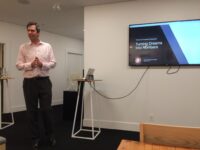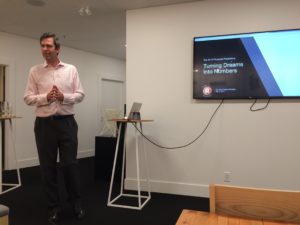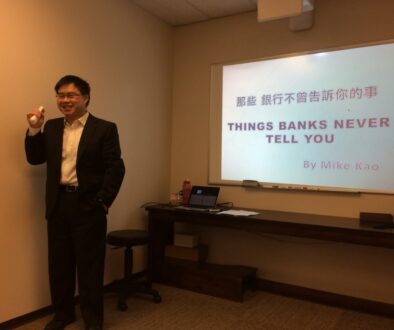The Art of Financial Projections – Turning Dreams into Numbers
Date: May 31, 2017
Name: The Art of Financial Projections – Turning Dreams into Numbers
Presenter: John Kay
Financial forecasting helps entrepreneurs understand the projection of their businesses; moreover, it can be a huge challenge for many entrepreneurs, especially at startups. Kabuni invites John Kay, the CEO of Realize Strategies, to discuss the technologies to build a realistic financial projection. In this presentation, John Kay will share the key elements in forecasting. He will simplify the overview on how to create the forecast. Entrepreneurs will able to apply the strategies to their businesses.
John Kay is the CEO and the Principal Consultant of Realize Strategies. For the past 5 years, he led his team to search financial solutions for many entrepreneurs. His strategies have helped and improved many companies to the next level. He is a Certified Management Accountant. Moreover, he volunteers as a Director-at-Large with The Shanti Uganda Society and the Chair of Board of Directors for Fairtrade Canada.
Turning Dreams into Numbers
Many people have great ideas. It is the “how” that frustrates them. The path from great idea to make banker happy is not easy for entrepreneurs. Financial projection will help entrepreneurs start their paths.
Is financial projection an art or science? Kay believes it is the mix of both. There is no magic bullet and entrepreneurs must anticipate that things do not always go according to plan.
There are 6 basic terms in any financial projection.
- Income Statement
- Balance Sheet
- Fixed cost
- Variable cost
- Cost of Goods sold
- Profit
Kay indicates Income Statement is the revenue over expense for a period of time. It shows profit after tax. For balance sheet, it has assets, liabilities, and equity. Asset is what entrepreneurs own, liability is what entrepreneurs owe, and equity is the net worth of the business. The total assets equals to the sum of the total liabilities and equity. Fixed cost is the cost that do not increase or decrease with sales, yet variable cost is the cost that do increase or decrease with sales. Cost of goods sold is the total cost of material, direct labor or any cost that is associated to the product.
Profit is the financial gain between revenue and expenses. There are 3 types of profits: gross, operating, and net. Gross profit comes from the difference between revenue and cost of goods sold. When entrepreneurs deduct all operating expenses from gross profit, it shows operating profit. Lastly, after taxes, it is net profit.
“Cash is King”
Kay wants entrepreneurs to remember that in any business, cash is king. If there is no cash flow, entrepreneurs are out of the business. Therefore, all matter is the bottom line.
In startups, when entrepreneurs are building financial projections, kay wants entrepreneurs to answer 2 questions.
- What will it cost to start my business?
- How much do I need to borrow?
Startup cost is essential. Many entrepreneurs ignore that cost and they experience difficulty operating the business at the beginning. Kay believes the important concept is to be conservative on the numbers. They need to understand what will it cost to operate their business even if they do not sell anything. That will be the fixed cost for the business.
Many people believe the opportunity is massive. They overestimate their projecting revenue. It takes time for startup to capture the right market, Kay advices entrepreneurs to be conservative and realistic.
Kay shares 2 bottom up approach. The first approach is called Breakeven. Entrepreneurs need to ask themselves how much they need to sell to breakeven. The second approach is called Estimates. Entrepreneurs can research their market and location to determine the right amount for their projections.
Kay shares 2 pricing strategies for entrepreneurs to determine their product price. The first strategy is called Cost Plus Pricing. Entrepreneurs can take the cost to produce the goods plus the required funds to cover the overhead and the expected funds to generate profit. In other words, the selling price is the combination of the total cost per unit plus the desire profit margin.
The second strategy is called Target Pricing. Entrepreneurs need to identify what will customer pay. Can they sell at that price or do they need to reduce production cost? The answer comes from the market research. When entrepreneurs do their market research, they will know how competitive their markets are in their industries. Entrepreneurs must understand the product characteristic, know the right cost drivers, and figure out the process and analysis in order to determine the right target price.
There are more pricing strategies. Kay has listed out some great pricing strategies.
| Penetration Pricing | Market Skimming | Psychological Pricing |
| Influence of Elasticity | Value Pricing | Going Rate (Price Leadership) |
| Contribution Pricing | Loss Leader | Tender Pricing |
| Marginal Cost Pricing | Price Discrimination | Predatory Pricing |
| Absorption or Full Cost Pricing | Destoryer Pricing |
To project revenue, entrepreneurs need to cover material costs, labor costs, and the margin. In order to know how much entrepreneurs need to sell. They can use the breakeven formula, which is the total fixed cost divided by the difference of the projected selling price and the total variable cost. Kay wants entrepreneurs to visit these 2 questions when they determine their breakeven numbers.
- Is it realistic?
- Can I make it work?
To project profit, entrepreneurs need to estimate sales required to generate profit. They need to determine their desired profit, contribution margin, and breakeven sales. Contribution margin is the difference between selling price and the total variable cost. The strategy to project profit is to work backwards. The required sales is the desired profit divided by the sum of the contribution margin and the breakeven sales. Again, entrepreneurs need to ask themselves if it is realistic.
Two important questions Kay wants entrepreneurs to ask is “what number do they want to charge their client?” and “how much do they want for themselves?”. To control the cash flow, Kay advices entrepreneurs to pay attention on the receivable. Do not to let receivable go crazy and pay attention to the inventory.
Kay recommends entrepreneurs to know their industries, keep it simple, know how much money they need and how much risk they can afford. Never overestimate and be realistic and cash flow is paramount.





